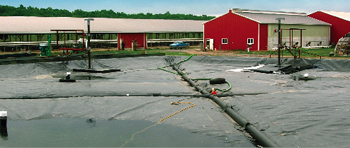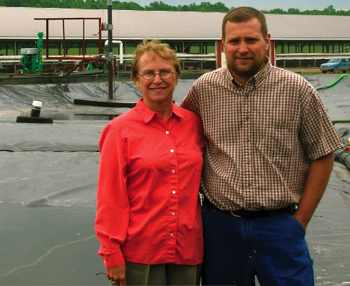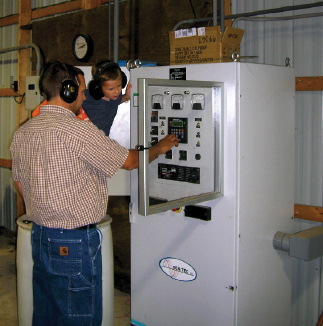
While the Patterson Dairy of New
York had a successful installation of its anaerobic digester system,
owner Connie Patterson still advises other dairies to do their homework
carefully, and not expect digester projects to be an automatic
slam-dunk.
While the Patterson Dairy of New York had a successful installation of its anaerobic digester system, owner Connie Patterson still advises other dairies to do their homework carefully, and not expect digester projects to be an automatic slam-dunk.
Regardless of the type or brand of anaerobic digester that a farm chooses to install, New York dairy farmer Connie Patterson has a piece of advice: be realistic about the work that it is going to involve from the farm end. In other words, don’t expect that building—and operating—the digester system is going to be a slam dunk.
 The Patterson Dairy opted for a complete mix digester from RCM Biothane, LLC. The complete mix digester produces biogas from a variety of organic wastes, which allows the farm to take in food waste, creating an additional revenue stream. The Patterson Dairy opted for a complete mix digester from RCM Biothane, LLC. The complete mix digester produces biogas from a variety of organic wastes, which allows the farm to take in food waste, creating an additional revenue stream. |
Part of the assumption that installing a digester system is going to be very straightforward (involving little time commitment from farm employees) may be due to wishful thinking on the part of farmers. But Patterson says that the digester providers themselves could also help out in this area.
“As a farm, we needed to be more realistic about what was involved. But I also think we need to get the information out there to the people who produce the digesters that they also need to communicate to the farm what it is going to take to be successful. It’s not just a matter of plugging the equipment in and it works,” she says.
Added to this is are the variations in operations and the variable nature of manure; it’s not as if digester engineers can base their design on handling manure that is going to be consistent whether the dairy farm is in New York or New Mexico.
The Patterson family knows of what they speak, having recently installed an anaerobic digester on their 1,000-head dairy farm in upstate New York. They toured a number of farms with different types of digester installations prior to taking the big step themselves. They heard a similar story from these farms: if the digester is going to work, you’ve got to work at it.
In the historical picture, the Pattersons have been at work on the dairy for some time. The dairy, which started out at 100 acres back in 1828, has been in the Patterson family for generations; Connie’s son, Jon, is the sixth generation of Pattersons to work on the farm. While the farm’s almost 180-year history has been one of changing with the times, there have been watershed moments. Perhaps the most eventful came in 1990 when the wooden barn that housed their 100 cows burned completely to the ground.
 Connie Patterson and son, Jon Patterson, of Patterson Dairy, with the dairy’s anaerobic digester. Installing a digester, Connie Patterson notes, is significantly different from any other farm improvement project. “It’s not like building a new parlor or adding to the barn. There are so many pieces to it, from financing to who is going to run it.” Connie Patterson and son, Jon Patterson, of Patterson Dairy, with the dairy’s anaerobic digester. Installing a digester, Connie Patterson notes, is significantly different from any other farm improvement project. “It’s not like building a new parlor or adding to the barn. There are so many pieces to it, from financing to who is going to run it.” |
While they were dealing with the shock of this, decisions still had to be made. “We had to regroup,” explains Patterson. “At first we took some cows and rented another barn, but that didn’t work out.” They essentially had to go all in or get out. “We decided to rebuild and broke ground on another piece or property in 1991.” Starting out with 400 cows, they shipped their first load of milk in January 1992.
“And of course, when you get bigger, manure becomes more of an issue.” The then-new dairy was set up with a pit with sufficient storage for about a week’s manure, with spreading done every week. They continued to grow, to 500 cows. Today, the operation has 1,500 dairy cows and heifers, and plants and harvests 2,400 acres of crops.
One year, they faced a particularly wet spring, and being unable to spread all the manure, made a deal with a neighbor to use his lagoon. That convinced them to ramp up their manure management program. The next step they took was to separate the solids, composting it, and using it for bedding. “Our bedding bill used to be $30,000 a year and I can’t imagine what it would be now if we were still buying bedding,” she says. They do buy a limited amount of bedding—straw in the winter and shavings in the summer, for the calf operations.
Bedding with the separated solids has resulted in challenges in keeping somatic cell counts down at times. They were able to achieve a decrease when they first started. They ran the first five years with counts of under 250, though lately it has been around 280. They are continuing to work on this, notably in getting the bedding more dry, to get the counts down.
The path to actually installing a digester to handle the biogas and manure from such a large operation was a bit lengthy, from considering the idea to the actual installation, but that was not necessarily a bad thing. Along the way, they were able to see a lot of digesters at work, develop some more sources of funding and—very importantly—set up a deal where they process food waste in the digester, which generates revenue.
“When we were first considering a digester in 2002, milk prices were down, so we decided not to go ahead,” Patterson explains. They already had approval for a grant of $381,000, which was re-scheduled. Attending an energy conference, Patterson later discovered that they could also apply for grants from the New York State Energy Research and Development Authority (NYSERDA) and the USDA, giving them a total of $1.2 million in funding to build the digester.
NYSERDA, a state government agency, offers financial and technical assistance to the State’s businesses, industries, municipalities, and residents to address New York’s energy and environmental needs. The agency offers incentives though a number of programs for various projects and initiatives such as new construction, energy efficiency improvements, wind and solar systems, and energy audits.
They opted to purchase a digester from RCM Biothane, LLC because the company has more working digesters in the market than anyone else, says Patterson, and have been happy with their choice. Almost half of the operating digesters in the US are RCM digesters, according to the company. It has constructed more than 35 digesters since 1982.
And they went for a complete mix digester. The complete mix digesters from RCM produce biogas from a variety of organic wastes with three to 10 percent total solids content. These digesters are heated and mixed to maintain a high level of bacterial activity to optimize energy production for the farm.
“We really wanted to be able to have a revenue stream, through taking in the food waste, so we went for the complete mix digester,” explains Patterson. “We knew we were going to be able to generate some electricity for the farm, but we thought it would not be much more than trading the cost of expensive electricity for the cost of running the digester, which is about where it is. Handling the food waste has been the real profitable area for us.”
They have a Department of Environmental Conservation permit to handle 18,000 gallons of food waste a day, which generates a healthy cash flow of tipping fees. All of the food waste comes from a Kraft cream cheese plant, about a four-and-a-half hour drive from the farm. Nearby Cornell University proved to be helpful in this regard, having developed a list of plants in the region that produced food waste.
“We spent some time visiting them, seeing what is out there,” says Patterson. “There was a lot of waste out there that would have required installing a chopper pump, and we did not want to go that route.”
Once things got underway, Patterson was fortunate in that her youngest son, Alex—who had just graduated in ag business from Cornell—was available to help out. Alex became the project manager, and a good thing, too. In the end, the total project involved an estimated 3,000 hours of farm labor.
There was the 135-foot by 142-foot by 17-foot gallon concrete tank, a 60-foot by 120-foot compost building, a 42-foot by 62-foot utility building, all of which was contracted out, but still had to be overseen. The engine, gas and hot water equipment all arrived on skids on one tractor trailer but, as Patterson says, “All the pieces still had to go together.”
Handling the material on the tail end of the setup is a new 16-inch Vincent screw press system. They’ve experimented with a few different screens on the Vincent, and seem to be on track towards getting optimal performance from the unit.
At this point, preliminary electrical power generation numbers and system operating costs are in, and it looks like the operating costs of running the engine are going to take up the savings the farm has in generating its own electrical power. How much they will get for selling their excess power remains to be seen. They produce about 190 kW an hour, and will use nowhere near that, with the exception of a few months in the summer when usage climbs to over 200 kW, due to running the barn fans. Currently, they will be compensated at the avoided cost rate for what they produce. Though this number is unknown, a payment will be made after 12 months of operation. This may change as New York State has come out with renewable power portfolio standards which may see a bonus paid on top of the standard rate. Patterson notes that premiums for this type of “green” energy are quite common in Europe.
 The power system at the Patterson Dairy, which produces about 190kW an hour, includes electronic monitoring so they can go on to an Internet website and see how much power is being produced, and other operating details. The power system at the Patterson Dairy, which produces about 190kW an hour, includes electronic monitoring so they can go on to an Internet website and see how much power is being produced, and other operating details. |
The system has electronic monitoring, so they can actually dial into an Internet website and see how much power is being produced, and other operating details. They run a Caterpillar engine from Martin Machinery, who gets high praise for their service and assistance. “I just can’t say enough about them,” says Patterson.
In the years to come, the Patterson operation will likely be achieving high productivity from the Cat engine; overseeing its operation is family member Jon Patterson, a diesel mechanic graduate and current crop/buildings manager.
Overall, Connie Patterson emphasizes that one of the key things to the success of her digester operation has been in being able to handle the food waste. “We’re lucky in that we have the acreage to handle that,” she says, noting that the 15,000 gallons per day of food waste is equivalent to handling the volume of manure from 800 more cows. “Someone who is right on the edge of his cows per acre would not be able to do this.
It also fits with her general philosophy of environmental improvements: if you are going to do the improvements, you have to find a new source of revenue to offset the costs. In this case, the new source of revenue in the form of tipping fees has offset the costs of the digester system. The $1.2 million in grants made it all possible in the first place, of course.
She adds that it’s important to remember that installing a digester is different from any other farm improvement project. “It’s not like building a new parlor or adding on to the barn. There are so many pieces to it, from financing to who is going to run it on a day-to-day basis.
“What we saw when we visited people with digester setups that were working well is that someone on that farm was driven to make it work. They were invested in it personally.” In the case of the Patterson operation, that would be son, Jon.
If it was a standard digester operation, handling only manure, there is, of course, always the incentive to make it work properly. But when you add on the extra revenue that farms can see from processing food waste, for example, there’s further incentive to be right on top of things.
Regardless of the type of digester, close management of the digester and associated equipment is required if it is going to make you money, rather than cost you money. Patterson notes that Curt Gooch of Cornell University’s Pro Dairy program has done studies illustrating the variability of plug flow digesters, with some digesters delivering up to a positive $40 in cash flow per cow, while with others, it’s a negative $30 per cow. In this study, the one complete mix digester was significantly more profitable.
Right now, the system takes an estimated 30 hours a week of someone’s time on the farm. “We’re still tweaking the system to get it right. We’re working on the separator, putting in a bigger flare.” The tweaking is not really related so much to operating the system as much as making sure they get maximum use of all the different components.
All that said, there is money to be made out of manure. Patterson points out there are a number of companies out there that will buy, install and operate digester systems on farms—provided they receive the revenue. “They wouldn’t be doing that unless it was profitable for them. There’s an opportunity for the farms to do that themselves and have that revenue stream.”
That revenue stream could be larger in the future at the Patterson Farm. Right now, they have far more biogas than they can handle with a single generator, and are considering another unit. And perhaps there are other opportunities, Patterson notes. In Sweden, for example, they use methane to produce methanol. “There are lots more opportunities on the energy side now with oil at $70 a barrel than there were even a year ago.”
In the near future, they will be adding to their storage, with another manure lagoon. “We want to look at handling the manure differently,” she says. It will likely be a two-stage lagoon; they want to try irrigating the slurry from the second stage. They currently have manure applied with a contract drag hose operation on about 300 acres around the barn.
As for future growth of the farm itself, Patterson says they are a good size in terms on their cow count. “We believe we’re big enough that size is no longer an issue. Now, we just need to hammer away at profitability.”